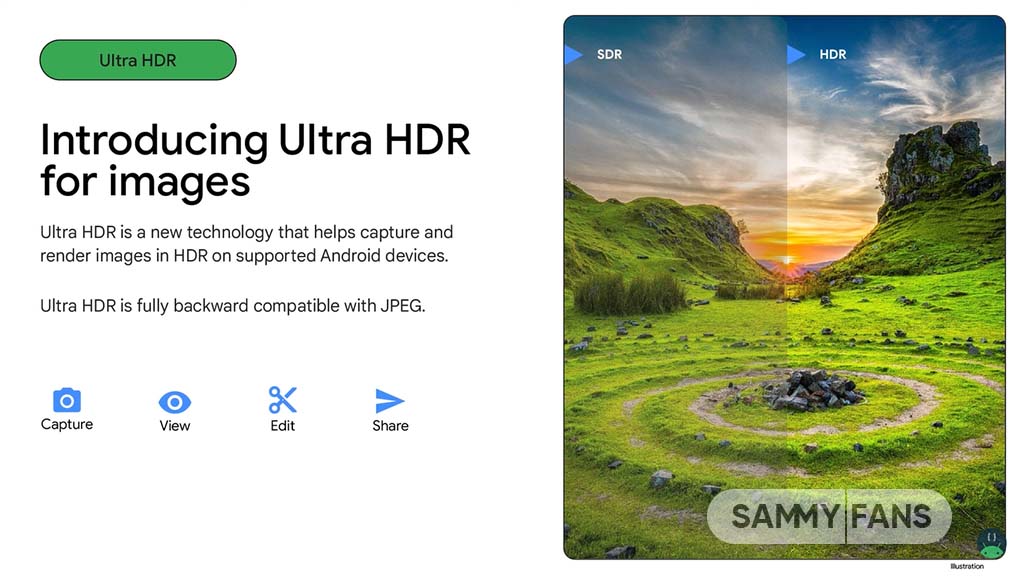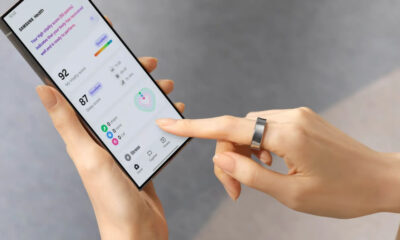News
Ultra HDR image is coming in Android 14, probably in One UI 6 too

Android 14 Beta testing is underway, with a target to achieve the platform stability milestone by the next month. At I/O, Google unveiled Ultra HDR support for Image, which arriving in Android 14, and probably in One UI 6 too for Samsung Galaxy devices.
With Android 13, Google added support for HDR video, and it’s now coming to Image in Android 14 with an Ultra label. This new feature will deliver more realistic stills, courtesy of a greater range of brightness, colors, and contrast. It will be known as the “Ultra HDR” format, which is backward compatible with JPEG.
Following the stable update rollout, expected in August, premium smartphones will offer an Ultra HDR Image feature and the files can also be saved in the original 10-bit high dynamic range. Android’s native Google Photos app will support Ultra HDR for display, backup, editing, sharing, and downloading.
Google expects it to be the default format on both the built-in camera app and any in-app camera views.
Additionally, the search engine giant confirmed that the Android team is working with tech giants such as Qualcomm to optimize hardware capabilities, along with a collaboration with Chrome to make Ultra HDR available on other form factors.

Ultra HDR image
Ultra HDR Image support for Android 14 is a new feature that allows Android devices to capture and display images with a wider range of colors and contrast than is possible with standard JPEG images. This is achieved by using a new 10-bit HDR image format that can capture up to 1 billion colors.
Its support for Android 14 will be available on devices that have a compatible camera sensor and display. To take advantage of this feature, you will need to update your device to Android 14 and use a camera app that supports Ultra HDR.
Once you have taken an Ultra HDR image, you can view it in HDR mode on a compatible device by opening it in the Google Photos app. The development team says you may be surprised at the difference it makes in your photos. Here are some of the benefits of using Ultra HDR Image support for Android 14:
- Wider range of colors and contrast
- More realistic and immersive viewing experience
- Improved detail in shadows and highlights

| Via |
News
Here’s why Google Messages replaced Samsung Messages on Galaxy devices

Samsung’s latest foldable phones come with Google Messages by default. The company has now revealed the reason behind this move on Galaxy devices. Samsung says Google Messages replaced Messages to foster RCS adoption.
According to AndroidAuthority, a source explained Samsung’s decision to switch to Google Messages as the default messaging app. The recently released Galaxy Z Flip 6 and Z Fold 6 come with Google Messages with RCS enabled by default.
Looks like promoting Google Messages on Galaxy devices will boost RCS adoption. Samsung Messages isn’t already installed on newer phones. However, one’s stopping you from getting it on your Galaxy from the Galaxy Store.
While many apps support the RCS feature, Google Messages offer the best user experience. Making it a default messaging app is an effort to boost the adoption of RCS tech. Apple is also preparing to bring RCS chat functionality to iMessage for iPhones.
What Samsung source said:
- Even if messaging apps follow the RCS standard, the availability may be limited depending on which app the other party uses. That’s why we decided to make Google Messages the common messaging platform, allowing Galaxy users to communicate more freely. This also enables a messaging app to respond to changes of the RCS standard more quickly and efficiently.
Previously, Samsung devices launched in the US came with two messaging apps. This time, the company has removed the Samsung Messages. During the first setup, users are notified that Google Messages is the default messaging application.
News
Samsung SmartThings gets ISO 27001 certified

Samsung SmartThings gained the international standard ISO/IEC 27001:2022 certification. The company has officially announced this major development in its global connected living platform.
SmartThings received ISO/IEC 27001:2022 certification for information security management systems. Certification reiterates that the SmartThings Cloud operates per international standards.
To be certified, a company has to meet the standard across a total of 123 detailed items, including policies for information security, access control for information assets, and incident response.
SmartThings receiving the ISO 27001 certification is the result of our sustained focus on the protection of information in a hyper-connected world with exponentially increasing intelligence.
Seungbum Choi, Executive Vice President and Head of Device Platform Center at Samsung Electronics said “this is just another step in our drive to fortify the platform’s security. We will continue to find new ways to ensure that SmartThings’ personalized services are provided even more safely.”

BSI Prez says that they have recognized that the operation capability and security level of Samsung SmartThings is excellent. It will further boost trust in the SmartThings platform and strengthen business competitiveness.
ISO 27001 is the leading global standard for ISMSs and was established by the International Organization for Standardization. It provides companies with guidance to manage the risks to information assets systematically and achieve information protection goals.
News
Dr.diary fuels Samsung Health with glycated hemoglobin algorithm
Samsung Health app integrated the Dr.diary (Doctor Diary) glycated hemoglobin feature. The blood sugar management platform announced the launch of its glycated hemoglobin estimation functionality on Samsung’s Health application.
According to ETNews, Dr.diary announced the integration of a glycated hemoglobin level feature in Samsung Health. Galaxy users will now be able to check the estimated glycated hemoglobin level provided by Doctor Diary.
To activate the feature, Health app users will have to permit certain conditions of data in the Blood Sugar service. It is worth noting that glycated hemoglobin is a key figure for diabetes diagnosis, which users will find worth using in the Health app.
Established in 2017, Dr.diary is a blood sugar management platform. It analyzes and predicts the changes in glycated hemoglobin using its own algorithm. Earlier this year, the firm secured a patent for “glycated hemoglobin estimation based on blood sugar data table.”
Song Je-yoon, CEO of Doctor Diary, said, “With our predicted glycated hemoglobin level prediction algorithm being installed in Samsung Health, more people will be able to recognize their glycated hemoglobin level and manage their health more efficiently.”

Glycated hemoglobin (HbA1c) is a standardized numerical value of the percentage of hemoglobin, such as hemoglobin, which has been glycated by glucose. Glycated hemoglobin reflects the average blood sugar level over the past 2-3 months.
Samsung Health (with Wear OS Galaxy Watch) users can conveniently check their estimated glycated hemoglobin level within the app and use this information to manage their blood sugar levels through diet and exercise.










